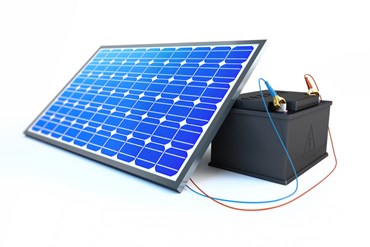
Flooded Lead Acid Batteries
Batteries used in most off‑grid renewable energy systems are deep‑cycle flooded lead‑acid batteries. These batteries can be charged and discharged (cycled) hundreds of times before they wear out.
Lead‑acid batteries contain three separate 2‑volt compartments, known as cells. Inside each cell is a series of thick parallel lead plates (Figure1). The cells are connected internally (wired in series) so that they produce 6‑volt electricity. The space between the plates is filled with sulfuric acid (hence the term "flooded"). A partition wall separates each cell, so that fluid cannot flow from one cell to the next. The cells are encased in a heavy‑duty plastic case.
As illustrated in Figure1, lead acid batteries contain two types of plates: positive and negative. The positive plates connect to a positive metal post or terminal; the negative plates connect to a negative post. The posts allow electricity to flow in and out of batteries.
Fig. 1: Anatomy of a Flooded Lead‑Acid Battery
The positive plates of lead‑acid batteries are made from lead dioxide (Pb02). The negative plates are made from pure lead. The sulfuric acid that fills the spaces between the plates is referred to as the electrolyte.
How Lead‑Acid Batteries Work
Like all other types of batteries, lead‑acid batteries convert electrical energy into chemical energy when they are charged. When discharging, that is, giving off electricity, chemical energy is converted back into electricity. The chemical reactions that take place during battery discharge are shown in Figure 2.
As illustrated, when electricity is drawn from a lead‑acid battery, sulfuric acid reacts with the lead of the negative plates (top reaction). This reaction yields electrons, tiny negatively charged particles. They flow out of the battery creating an electrical current. During this reaction, lead on the surface of the negative plates is converted to tiny lead sulfate crystals.
Fig. 2: Chemical Reactions in a Lead‑Acid Battery.
When a battery is discharging, sulfuric acid also reacts with the lead dioxide of the positive plates, resulting in the formation of lead sulfate crystals on them as well (see bottom panel). Discharging a battery not only creates lead sulfate crystals on the positive and negative plates, it depletes the amount of sulfuric acid in the battery. When the battery is charged, however, lead sulfate crystals on the positive and negative plates are broken down, releasing sulfate ions into solution, thus replenishing the sulfuric acid. (The reactions that take place during recharge are the reverse of those that occur during discharge.)
Although the chemistry of lead‑acid batteries is a bit complicated, it is important to remember that this system works because electrons can be stored in the chemicals within the battery when a battery is charged. The stored electrons can be drawn out by reversing the chemical reactions. Through this reversible chemical reaction, the battery is acting as a"charge pump:' moving electrical charges through a circuit on demand.